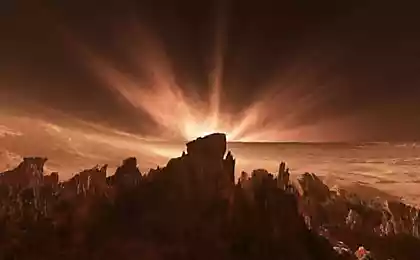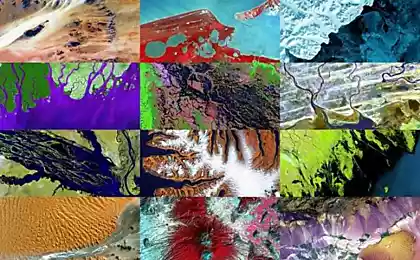986
Easy space educational program. Photos, videos and descriptions.
Descriptions did himself, plus materials in English, so that please do not kick, well, I'm not an astronomer.
Description top photo below. Happy viewing;)

14 shots.
1) «Not a Blue Moon» - a bright "blue" moon, filmed in Turin, Italy. Blue full moon tend to appear in a particular month every 2, 5 years.

2) «A Force from Empty Space: The Casimir Effect» - this little ball - proof that the universe will expand forever (always), and not fate us to collapse. Being a little more than one tenth of a millimeter, it moves to the smooth plate, so in response to energy fluctuations in the vacuum of empty space. This attraction is known as the Casimir Effect, named for its discoverer, who 50 years ago was trying to understand why such a liquid as mayonnaise - is moving so meeedlennnooo O_o
Today we know that the greatest energy density concentrated in dark matter. The form and genesis of dark matter is absolutely not understood, but scientists have hypothesized that these fluctuations in the vacuum to the Casimir effect, correlated with the universe and dark matter. Now this is a very important area of research.
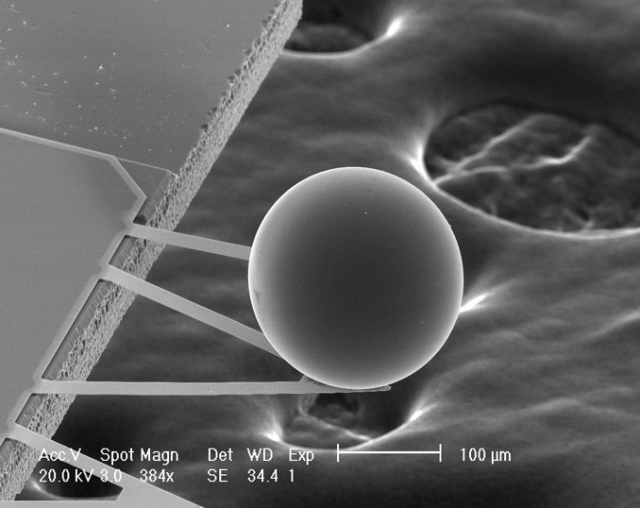
3) «Comet Halley's Nucleus: An Orbiting Iceberg» - The photo of the comet nucleus. There is a thought that formed from the original material of the solar system, cometary nuclei resemble very dirty icebergs. Ground-based telescopes revealed only the surrounding cloud of gas and dust from the comet approaches the sun. However, in 1986, the European spacecraft Giotto, located 15 km from the comet Halley, photographed its nucleus. Every 76 years, it comes back and loses 6 meters of ice and rock from the surface into space.
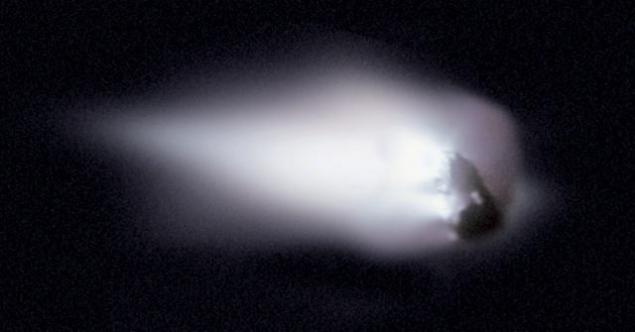
4) «The Spotty Surface of Betelgeuse» - this red smeared blyamba - beautiful Betelgeuse.
Big Star. If it washed down into our solar system instead of the existing light, then she pulled up to the orbit of Jupiter. But even in large telescopes, it appears as a small point of light. Astronomers using interferometry at infrared wavelengths, can reconstruct the surface of the red giant. This photo shows two large, bright spots on its surface. These spots - convective cell growth, rising from under the surface of the super-giant. They are bright due to the fact that the remaining surface is warmer, but they colder surface of the sun. Betelgeuse is 600 light-years away from that of the Earth.
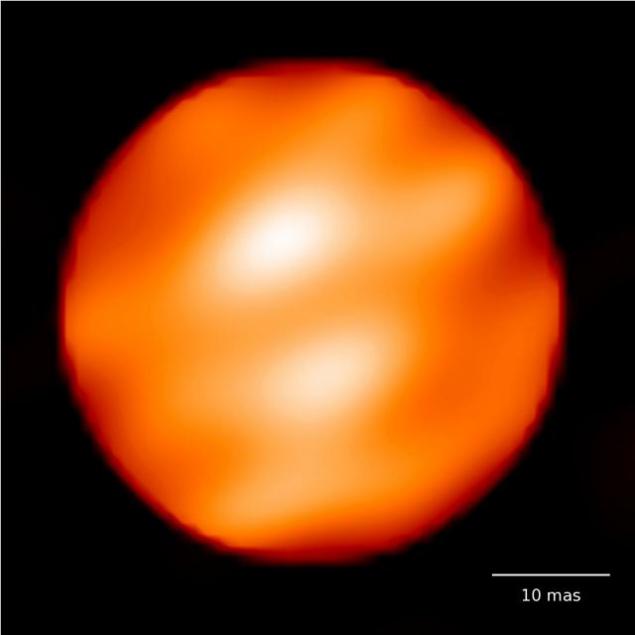
5) «The Tail of the Small Magellanic Cloud» - as is well known Milkivey (Milky Way), the one that snake, did not sink in the milk, no matter how hard you try, better known as the Milky Way.
The photo - Small Magellanic Cloud, shot telescope Spitzer. As I understand it - is the tail of our galaxy.

6) «Andromeda Island Universe» - one picture and her name would probably suffice, but ...
The most distant object visible to the eye is M31, the great Andromeda galaxy, which is about two and a half million light-years from us. But even this immense spiral galaxy spanning 200,000 light-years, without telescopes, looks like a foggy cloud in the constellation Andromeda. In this photo can be seen as part of its bright yellow nucleus and dark winding dust lanes.
In the 20s there were a lot of debate about whether these spiral galaxies have found part of the Milky Way galaxy, and yet it is independent of the "island universe" - distant systems of stars comparable Milkiveyu. The dispute was later resolved in favor of the last statement.

7) «The Astronaut Who Captured a Satellite» - In this photo, the 1984 Astronaut Dale A. Gardner grabs satellite Westar 6, the failed and never reached geostationary orbit. Next caught Westar 6 satellite was sent to Earth in the cargo henceforth ship Discovery, which later was repaired and sold to the crap for money.

8) «The Flame Nebula in Infrared" - a very big picture. In one and a half thousand light-years from Earth in the constellation of Orion is the Flame Nebula. The photo shows the star Alnitak, the easternmost star in Orion's belt. As I understood, Flame nebula glows because of the fact that the star Alnitak shines into it, knocking electrons out of large clouds of hydrogen gas.

9) "M94: A New Perspective» - the beautiful island universe M94 is a 15-million light-years away in the constellation Hunting Dogs. Spiral M94 is surrounded by a wide ring of stars because the external disk galaxy is actively involved in their formation.

10) «Atlantis to Orbit» - The Statue of Liberty weighs less. Space Launch awe-inspiring. This photo shows the space shuttle Atlantis launch. July 12, 2001, the next 2 million kilograms of high-tech scrap were sent into space. Now missiles already in pieces a week run.

11) «Dust and the NGC 7771 Group» - the galaxy NGC 7771. the group is 200 million light-years away in the constellation Pegasus.
The photo shows two interacting galaxies with each other, which ultimately lead to their merger into one as they always happens. This interaction can be traced to weak stream of stars and distortion of galaxies caused by gravitational forces.

12) «Millennium Annular Solar Eclipse» - 15 January last year, the Moon's shadow passed over the earth, forming an annular solar eclipse. Depending on the place of observation, the eclipse could last right up 11ti minutes and 8 seconds. And yes, it was the longest solar eclipse of the subsequent thousand years. And where were you this time?
The photo was taken in the southern part of India, in the city called, and believe that it is impossible - Kanyakumari.
Fans of clever phrases - As a result, around the dark disk of the moon is clearly visible granulation, arising due to thermal convection in the solar atmosphere.

13) «Eclipses in the Shade» - the picture was taken on the atoll Ellaydhu belonging to the Maldives in the Indian Ocean.
Just photographed beach during the eclipse, like this left no shadow of palm trees.

14) «The Magellanic Stream» - Behind the majestic Magellanic Clouds in the sky stretches an unusual stream of gas: the Magellanic Stream. The origin of this gas remains unknown. Realizing it, we will be able to learn more about the origin and future of the two best-known satellites of our Milky Way: the LMC and SMC. Until recently, most likely considered two hypotheses: that the flow of gas was formed, lost Magellanic Clouds in passing through the halo of our Milky Way, or that the flow has arisen as a result of the differential gravitational attraction of the Milky Way. However, recent wide-angle radio images - including those received on radio Byrd Green Bank - have shown that the Magellanic Stream is longer and older than previously thought. Perhaps his age is 2.5 billion years old. These observations support the hypothesis of a third possible origin of the stream - that the Large and Small Magellanic Clouds once passed so close to each other that gravitational tides caused a burst of star, which remained after the flow. Pictured radio image of the Magellanic Stream, shown in pink, it is imposed on the newly created image of the entire sky in visible light. It can be seen that the flow stretched across the sky and ends about two Magellanic galaxies at bottom right.

15) «The Known Universe» This is a video-production travel from Earth to the bubble universe. Captures video. -
16) «Watch Jupiter Rotate» - This is a video of what the picture can be seen, if you were on board the spacecraft "New Horizons" (good tickets sold in advance), flown in 2007, around Jupiter. The video shows the band and belt light and dark clouds, as well as giant rotating storms that look like ovals. The diameter of Jupiter is about eleven times larger than the Earth, and the period of rotation is about 10 hours. The robot spacecraft "New Horizons", launched five years ago, the rate increases and sent to the outskirts of the solar system. He had already flown half way from Earth to Pluto, and Pluto is expected to arrive in 2015.
Finally.
Great song Basil Shestovtsa and Xenia Larionova "We'll fly».
Description top photo below. Happy viewing;)

14 shots.
1) «Not a Blue Moon» - a bright "blue" moon, filmed in Turin, Italy. Blue full moon tend to appear in a particular month every 2, 5 years.

2) «A Force from Empty Space: The Casimir Effect» - this little ball - proof that the universe will expand forever (always), and not fate us to collapse. Being a little more than one tenth of a millimeter, it moves to the smooth plate, so in response to energy fluctuations in the vacuum of empty space. This attraction is known as the Casimir Effect, named for its discoverer, who 50 years ago was trying to understand why such a liquid as mayonnaise - is moving so meeedlennnooo O_o
Today we know that the greatest energy density concentrated in dark matter. The form and genesis of dark matter is absolutely not understood, but scientists have hypothesized that these fluctuations in the vacuum to the Casimir effect, correlated with the universe and dark matter. Now this is a very important area of research.

3) «Comet Halley's Nucleus: An Orbiting Iceberg» - The photo of the comet nucleus. There is a thought that formed from the original material of the solar system, cometary nuclei resemble very dirty icebergs. Ground-based telescopes revealed only the surrounding cloud of gas and dust from the comet approaches the sun. However, in 1986, the European spacecraft Giotto, located 15 km from the comet Halley, photographed its nucleus. Every 76 years, it comes back and loses 6 meters of ice and rock from the surface into space.

4) «The Spotty Surface of Betelgeuse» - this red smeared blyamba - beautiful Betelgeuse.
Big Star. If it washed down into our solar system instead of the existing light, then she pulled up to the orbit of Jupiter. But even in large telescopes, it appears as a small point of light. Astronomers using interferometry at infrared wavelengths, can reconstruct the surface of the red giant. This photo shows two large, bright spots on its surface. These spots - convective cell growth, rising from under the surface of the super-giant. They are bright due to the fact that the remaining surface is warmer, but they colder surface of the sun. Betelgeuse is 600 light-years away from that of the Earth.

5) «The Tail of the Small Magellanic Cloud» - as is well known Milkivey (Milky Way), the one that snake, did not sink in the milk, no matter how hard you try, better known as the Milky Way.
The photo - Small Magellanic Cloud, shot telescope Spitzer. As I understand it - is the tail of our galaxy.

6) «Andromeda Island Universe» - one picture and her name would probably suffice, but ...
The most distant object visible to the eye is M31, the great Andromeda galaxy, which is about two and a half million light-years from us. But even this immense spiral galaxy spanning 200,000 light-years, without telescopes, looks like a foggy cloud in the constellation Andromeda. In this photo can be seen as part of its bright yellow nucleus and dark winding dust lanes.
In the 20s there were a lot of debate about whether these spiral galaxies have found part of the Milky Way galaxy, and yet it is independent of the "island universe" - distant systems of stars comparable Milkiveyu. The dispute was later resolved in favor of the last statement.

7) «The Astronaut Who Captured a Satellite» - In this photo, the 1984 Astronaut Dale A. Gardner grabs satellite Westar 6, the failed and never reached geostationary orbit. Next caught Westar 6 satellite was sent to Earth in the cargo henceforth ship Discovery, which later was repaired and sold to the crap for money.

8) «The Flame Nebula in Infrared" - a very big picture. In one and a half thousand light-years from Earth in the constellation of Orion is the Flame Nebula. The photo shows the star Alnitak, the easternmost star in Orion's belt. As I understood, Flame nebula glows because of the fact that the star Alnitak shines into it, knocking electrons out of large clouds of hydrogen gas.

9) "M94: A New Perspective» - the beautiful island universe M94 is a 15-million light-years away in the constellation Hunting Dogs. Spiral M94 is surrounded by a wide ring of stars because the external disk galaxy is actively involved in their formation.

10) «Atlantis to Orbit» - The Statue of Liberty weighs less. Space Launch awe-inspiring. This photo shows the space shuttle Atlantis launch. July 12, 2001, the next 2 million kilograms of high-tech scrap were sent into space. Now missiles already in pieces a week run.

11) «Dust and the NGC 7771 Group» - the galaxy NGC 7771. the group is 200 million light-years away in the constellation Pegasus.
The photo shows two interacting galaxies with each other, which ultimately lead to their merger into one as they always happens. This interaction can be traced to weak stream of stars and distortion of galaxies caused by gravitational forces.

12) «Millennium Annular Solar Eclipse» - 15 January last year, the Moon's shadow passed over the earth, forming an annular solar eclipse. Depending on the place of observation, the eclipse could last right up 11ti minutes and 8 seconds. And yes, it was the longest solar eclipse of the subsequent thousand years. And where were you this time?
The photo was taken in the southern part of India, in the city called, and believe that it is impossible - Kanyakumari.
Fans of clever phrases - As a result, around the dark disk of the moon is clearly visible granulation, arising due to thermal convection in the solar atmosphere.

13) «Eclipses in the Shade» - the picture was taken on the atoll Ellaydhu belonging to the Maldives in the Indian Ocean.
Just photographed beach during the eclipse, like this left no shadow of palm trees.

14) «The Magellanic Stream» - Behind the majestic Magellanic Clouds in the sky stretches an unusual stream of gas: the Magellanic Stream. The origin of this gas remains unknown. Realizing it, we will be able to learn more about the origin and future of the two best-known satellites of our Milky Way: the LMC and SMC. Until recently, most likely considered two hypotheses: that the flow of gas was formed, lost Magellanic Clouds in passing through the halo of our Milky Way, or that the flow has arisen as a result of the differential gravitational attraction of the Milky Way. However, recent wide-angle radio images - including those received on radio Byrd Green Bank - have shown that the Magellanic Stream is longer and older than previously thought. Perhaps his age is 2.5 billion years old. These observations support the hypothesis of a third possible origin of the stream - that the Large and Small Magellanic Clouds once passed so close to each other that gravitational tides caused a burst of star, which remained after the flow. Pictured radio image of the Magellanic Stream, shown in pink, it is imposed on the newly created image of the entire sky in visible light. It can be seen that the flow stretched across the sky and ends about two Magellanic galaxies at bottom right.

15) «The Known Universe» This is a video-production travel from Earth to the bubble universe. Captures video. -
16) «Watch Jupiter Rotate» - This is a video of what the picture can be seen, if you were on board the spacecraft "New Horizons" (good tickets sold in advance), flown in 2007, around Jupiter. The video shows the band and belt light and dark clouds, as well as giant rotating storms that look like ovals. The diameter of Jupiter is about eleven times larger than the Earth, and the period of rotation is about 10 hours. The robot spacecraft "New Horizons", launched five years ago, the rate increases and sent to the outskirts of the solar system. He had already flown half way from Earth to Pluto, and Pluto is expected to arrive in 2015.
Finally.
Great song Basil Shestovtsa and Xenia Larionova "We'll fly».















